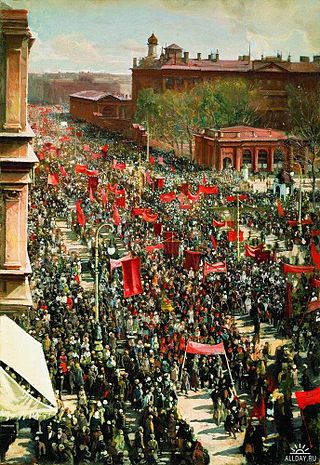
Alexander Ney is an American sculptor and painter. After establishing himself in 1972 as a resident of France, he immigrated to the United States in 1974 and has since lived and worked in New York City. Developing several individualistic styles in modern art, he is most famous for his unique work in terra cotta sculpture, involving heavily perforated surfaces and intriguing forms.
Soviet nonconformist art was Soviet art produced in the former Soviet Union outside the control of the Soviet state started in the Stalinist era, in particular, outside of the rubric of Socialist Realism. Other terms used to refer to this phenomenon are Soviet counterculture, "underground art" or "unofficial art".

Ivan Shadr, pseudonym of Ivan Dmitriyevich Ivanov was a Russian/Soviet sculptor and medalist who took his pseudonym after his hometown of Shadrinsk.

The Moscow Museum of Modern Art is a museum of modern and contemporary art located in Moscow, Russia. It was opened to public in December 1999. The project of the museum was initiated and executed by Zurab Tsereteli, president of the Russian Academy of Arts. In 2018, The Vadim Sidur Museum and Museum-Studio of Dmitry Nalbandyan are branches of the Moscow Museum of Modern Arts.

Ivan Petrovich Martos was a Russian sculptor and art teacher of Ukrainian origin who helped awaken Russian interest in Neoclassical sculpture.

The Muzeon Park of Arts is a park outside the Krymsky Val building in Moscow shared by the modern-art division of the Tretyakov Gallery and the Central House of Artists. It is located between the Park Kultury and the Oktyabrskaya underground stations. The largest open-air sculpture museum in Russia, it has over 1,000 artworks currently in its collection.

Zurab Konstantinovich Tsereteli is a Georgian-Russian painter, sculptor and architect known for large-scale and at times controversial monuments. Tsereteli has served as the President of the Russian Academy of Arts since 1997.

Oleg Yuriyevich Buryan is a Russian artist, who lived in Moscow from the 1980s. In 2012, he moved to St-Petersburg, where he joined the St-Petersburg Union of Artists. He belongs to the first generation of post-Soviet creators, integrated in the international context.

Soviet art is the visual art style produced after the Russian Revolution of 1917 and during the existence of the Soviet Union, until its collapse in 1991. The Russian Revolution led to an artistic and cultural shift within Russia and the Soviet Union as a whole, including a new focus on socialist realism in officially approved art.
The year 1924 was marked by many events that left an imprint on the history of Soviet and Russian Fine Arts.

Vadim Gushchin is a Russian art-photographer.

Igor Vulokh was a Russian nonconformist artist of the 1960s, a leading exponent of abstraction in Russian art.

Mikhail Averyanovich Panikakha was a Red Army soldier. He was posthumously awarded the title Hero of the Soviet Union for destroying a German tank with two Molotov cocktails while on fire during the Battle of Stalingrad.

Dmitry Kawarga born in Moscow, Russia is a Russian artist. Kawarga began working in his own style of "biomorphism" striving to create a synthesis of science, art and technology. His art is featured in numerous museums and is part of the permanent collection of Erarta, Russia's largest private museum of contemporary art located in Saint Petersburg.
Yuri Ivanovich Bosco was a Russian artist, an Honored Artist of the RSFSR (1963) and People's Artist of the Russian Federation (2006).

The fine art of Leningrad is an important component of Russian Soviet art—in the opinion of the art historians Vladimir Gusev and Vladimir Leniashin, "one of its most powerful currents". This widely used term embraces the creative lives and the achievements of several generations of Leningrad painters, sculptors, graphic artists and creators of decorative and applied art from 1917 to the early 1990s.

Dmitry Zhukov is a Russian sculptor, known for monumental metal works made in the technique of forging, a member of the Russian Artists' Union.

The Monument to Leo Tolstoy on Prechistenka was installed in Moscow in the courtyard of the State Museum of Leo Tolstoy. The granite sculpture was made in 1913 by sculptor Sergey Merkurov, and has been in its current location since 1972.

Petr Aleksandrovich Maslov – is a Russian graphic and installation artist, and book designer. Grandson of the famous Russian sculptor Isidor Grigorievich Frih-Khar

Yuri Avvakumov is a Russian architect, artist, and curator. He became a member of the Union of Architects of Russia in 1985, a Corresponding Member of the Russian Academy of Arts in 2012, and a Full Member in 2017. Avvakumov has represented Russia at the Venice Biennale three times.



















